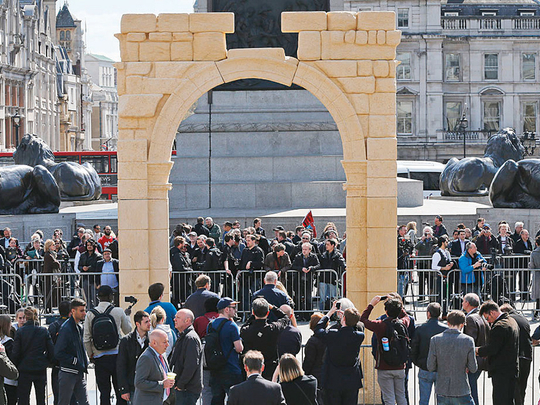
Dubai: A 3D-printed replica of Palmyra’s Arch of Triumph, which was created by the Dubai Future Foundation (DFF) to immortalise the historical gateway to the ancient Syrian city, has won the Public Engagement with Research Award, sponsored by the vice-chancellor of the University of Oxford.
The replica is the fruit of a strategic partnership between DFF, the United Nations Educational, Scientific and Cultural Organisation (Unesco), the British Institute for Digital Archaeology, and the Universities of Oxford (UK) and Harvard (USA).
The international project seeks to document archaeological sites at risk around the Middle East region using 3D imaging, and then reconstructing them using 3D-printing technology. The end goal is to safeguard the region’s rich history and cultural heritage from vandalism and destruction.
“This initiative is a direct implementation of the UAE leadership’s forward-thinking vision, which calls for utilising the technologies of the future to preserve our region’s ancient heritage,” said DFF’s acting CEO Abdullah Bin Toq.
He added that receiving Oxford University’s Public Engagement with Research Award demonstrates the global recognition of DFF’s success with the Palmyra Arch of Triumph replica.
“It is an acknowledgement of the soundness of DFF’s Dubai Future Agenda. The foundation is a trailblazer when it comes to tapping cutting-edge technologies to preserve human and cultural heritage for future generations,” said Bin Toq.
He said that the Palmyra Arch of Triumph project is an incentive for the foundation to carry on with its mission, alongside strategic partners from around the world.
Speaking on the occasion, Professor Louise Richardson, vice-chancellor of Oxford University, said: “The award has had an impressive turnout this year; we have received a great deal of groundbreaking scientific research and innovative projects. This reflects our commitment to encouraging the scientific community to get involved with the award, and to draw participants from all segments of society and across all sectors.”
The first replica of the Palmyra Arch of Triumph was created in Italy and then showcased in major cities, including London’s Trafalgar Square, New York City’s City Hall Plaza, Dubai at the World Government Summit, Florence during the G7 Summit, and the Khaled Al Asaad Archaeological Museum in Arona, Italy.
The replica is roughly two-thirds the size of the original arch, measuring 5.5 metres in height and made out of marble using 3D-printing technology, while the replica weighs 11 tonnes and stands 20-foot tall.
The Oxford University vice-chancellor’s award is one of the most prestigious and outstanding international awards that promote scientific research and community participation. The award includes three categories: Projects, Building Capacity and Early Career Researcher.








